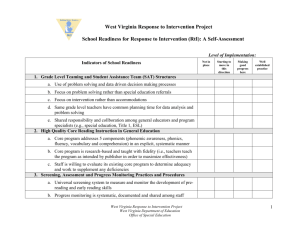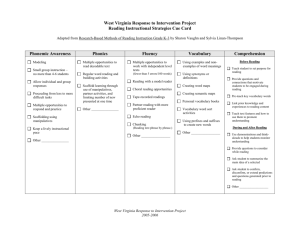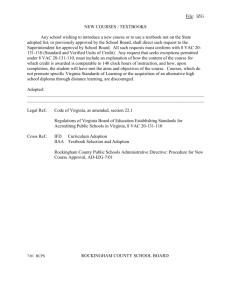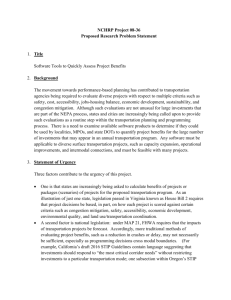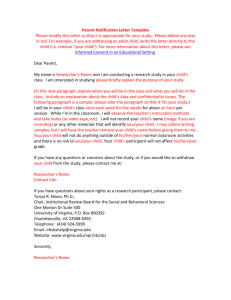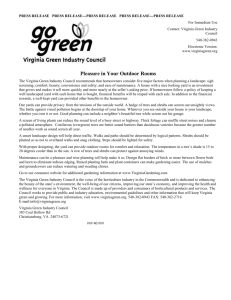EXECUTIVE SUMMARY - West Virginia Department of Education
advertisement
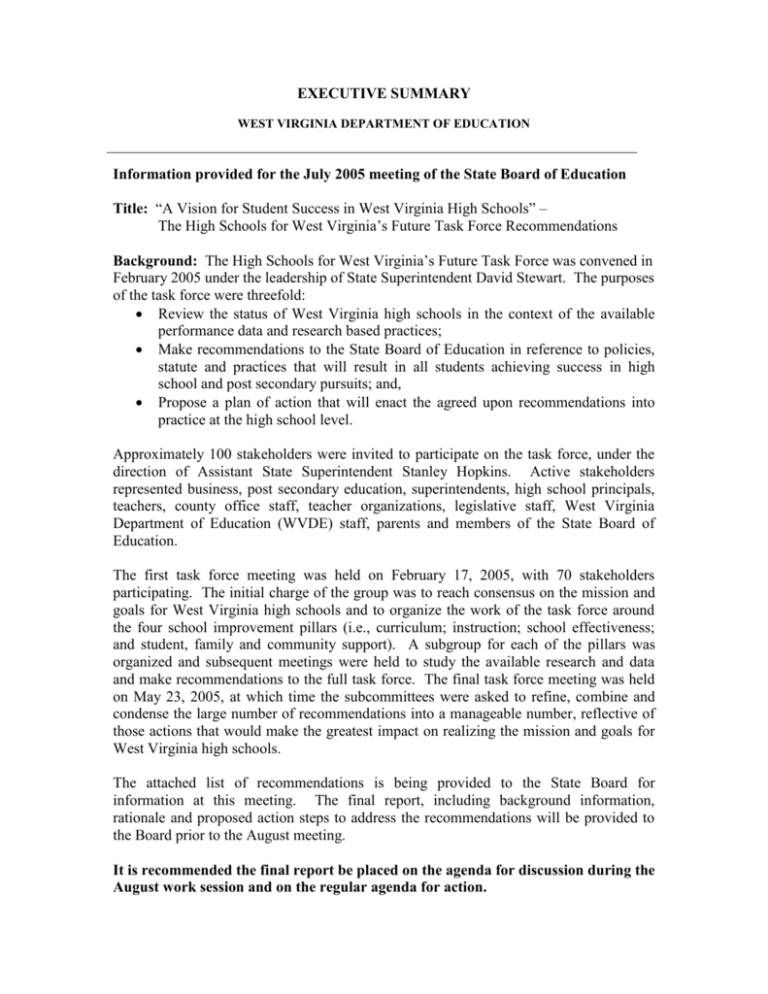
EXECUTIVE SUMMARY WEST VIRGINIA DEPARTMENT OF EDUCATION Information provided for the July 2005 meeting of the State Board of Education Title: “A Vision for Student Success in West Virginia High Schools” – The High Schools for West Virginia’s Future Task Force Recommendations Background: The High Schools for West Virginia’s Future Task Force was convened in February 2005 under the leadership of State Superintendent David Stewart. The purposes of the task force were threefold: Review the status of West Virginia high schools in the context of the available performance data and research based practices; Make recommendations to the State Board of Education in reference to policies, statute and practices that will result in all students achieving success in high school and post secondary pursuits; and, Propose a plan of action that will enact the agreed upon recommendations into practice at the high school level. Approximately 100 stakeholders were invited to participate on the task force, under the direction of Assistant State Superintendent Stanley Hopkins. Active stakeholders represented business, post secondary education, superintendents, high school principals, teachers, county office staff, teacher organizations, legislative staff, West Virginia Department of Education (WVDE) staff, parents and members of the State Board of Education. The first task force meeting was held on February 17, 2005, with 70 stakeholders participating. The initial charge of the group was to reach consensus on the mission and goals for West Virginia high schools and to organize the work of the task force around the four school improvement pillars (i.e., curriculum; instruction; school effectiveness; and student, family and community support). A subgroup for each of the pillars was organized and subsequent meetings were held to study the available research and data and make recommendations to the full task force. The final task force meeting was held on May 23, 2005, at which time the subcommittees were asked to refine, combine and condense the large number of recommendations into a manageable number, reflective of those actions that would make the greatest impact on realizing the mission and goals for West Virginia high schools. The attached list of recommendations is being provided to the State Board for information at this meeting. The final report, including background information, rationale and proposed action steps to address the recommendations will be provided to the Board prior to the August meeting. It is recommended the final report be placed on the agenda for discussion during the August work session and on the regular agenda for action. HIGH SCHOOLS FOR WEST VIRGINIA’S FUTURE TASK FORCE MISSION All West Virginia high school students will graduate with the knowledge and skills needed for success in post secondary education, the workplace and life. GOALS 1. Students’ academic and technical performance shall equal or exceed national averages. 2. Students shall have the opportunity to complete accelerated courses and graduate with college credit and/or workplace credentials. 3. Students will be educated by highly qualified personnel who effectively use researchbased instructional strategies. 4. Students shall receive academic and career guidance to make informed decisions about career paths. 5. Students shall receive a seamless high school curriculum designed and delivered to promote lifelong learning. 6. Students’ families and communities shall be involved to assure that all schools have strategies for providing support to address social, emotional and academic needs. To facilitate communications and organization, the following task force recommendations, designed to address the mission and goals, have been categorized under the five action statements for high school reform put forth by the National Governor’s Association Action Agenda for Improving America’s High Schools. ii A Vision for Student Success in West Virginia High Schools: High Schools for West Virginia’s Future Task Force Recommendations (July 2005) Mission: All West Virginia high school students will graduate with the knowledge and skills needed for success in postsecondary education, the workplace and life. 1. Increase the Value of the West Virginia High School Diploma Assure curricula are aligned to provide relevance and rigor for student postsecondary and career success. o Revise career clusters/majors/pathways to assure required and recommended courses are relevant to students’ postsecondary and career success o Review/revise Content Standard and Objectives (CSOs) for high school courses to ensure that 21st Century Skills are emphasized o Provide quality experiential and work-based learning experiences for all students o Assure student mastery of CSOs as the basis for awarding credit Make the senior year more challenging and meaningful for students. o Seniors will be fully enrolled in meaningful coursework (students would be expected to complete at least five credits) o Students will graduate with postsecondary credits and/or industry credentials/experiences o All students will complete a culminating senior project Provide college and work readiness credentials for all students. o Explore the use of formative assessments, end-of-course exams, employment exams, ACT, SAT, WorkKeys®, Advanced Placement (AP) exams, and senior assessments as the basis for establishing criteria for college and work readiness credentials o Provide “college readiness certificates” for students who meet the criteria as “college ready”, reducing the number of students enrolled in college “developmental” skills courses o Provide “work-readiness certificates” for students who meet the criteria as “work ready” and engage the business community in recognizing the value of the certificate 1 2. Redesign the West Virginia High School Experience Increase learning opportunities for students. o Provide schools flexibility for modification of time, schedules, and organization so that all students attain mastery o Revise Policy 4110 to make attendance at school a “student priority” o Fund, implement, and monitor structured “extra help” (e.g. dropout prevention, before and after school programs, summer programs, credit recovery, double dosing, extended year/day) o Provide equal access to advanced learning opportunities (Earn a Degree – Graduate Early (EDGE), AP, dual credit, industry credentials, college courses) o Expand the use of distance learning (e.g., virtual courses, on-line) to provide access to required, elective and advanced courses o Increase the utilization and relevance of technology as an instructional tool Engage students in relevant and rigorous curricula and instruction. o Review graduation requirements in terms of rigor and relevance o Design structured “credit recovery” programs for “at risk” students o Implement research-based instructional strategies to increase student engagement and achievement o Increase the number of students taking AP classes and AP exams; EDGE courses; dual credit courses; and, college courses o Increase the number of students earning industry credentials o Determine “student learning performance” based on mastery, not time o Instruct students in monitoring and assessing their skills as they take “ownership” of their learning o Collaborate with post-secondary education and business/industry partners to develop a relevant and rigorous “seamless curriculum” o Establish a state-wide high school cadre that works toward strengthening instruction to maximize student learning Initiate a three-year professional development strategy for all principals and teachers that will assure that what takes place in the classroom strengthens the high school experience through the following practices. o Differentiated instruction o Research-based strategies o Project-based learning o Integration/Interdisciplinary learning o Student portfolios and student led conferencing o Multi-cultural communication skills o Assessment, including alternative forms o Mentor training o Standards-based instruction and lesson design o Curriculum alignment and prioritization o Instructional Technology 2 Increase guidance and advisement activities for informed decision-making. o Revise Policy 2315 to establish grade level standards for guidance and advisement o Provide mentors for all students o Review the delivery of the Developmental Guidance model and add relevant CSOs o Provide funding within the school aid formula for increased counseling services o Improve the preparation of school counselors o Utilize ACT PLAN results as a viable career planning tool Improve “student transitioning” from middle grades to high school. o Establish “readiness standards” for high school o Implement a technology literacy requirement and assessment for grade eight (8) o Use ACT EXPLORE results to review high school readiness o Realign middle schools to prepare students for a rigorous high school curriculum o Provide meaningful programs to support “at-risk” students 3. Support West Virginia Student Success with Excellent Teachers and Principals Provide teachers and principals with instructional resources, time, and ongoing professional development for implementing new curricula and research-based instructional methods. o Fund and monitor additional days to provide school-embedded, research-based professional development to drive change o Fund and establish ten (10) pilot sites at high schools or technical centers to implement the “professional learning community” model o Redesign the school day and schedule to promote teacher collaboration Recruit, employ, and retain effective teachers and principals. o Develop (in collaboration with higher education) state-wide teacher and principal preparation standards that will be uniform throughout all WV higher education institutions o Review and revise policies, practices and statues to facilitate the recruitment, employment and retention of highly effective teachers and principals 3 4. Hold West Virginia High Schools Accountable for Student Success by Setting Meaningful Benchmarks and Intervening in Low-performing High Schools Create a state accountability system that expects high performing high schools for all students that may include the following measures or practices. o Required attendance o Increasing graduation rates o Decreasing drop out rates o Performance on the ACT o End-of course exams and formative assessments o College and work readiness certificates o Senior assessments o Perceptual data--senior student surveys, parent and teacher surveys o Successful postsecondary transition, including a follow up of graduates Review and revise policies and laws that support student accountability for learning (e.g. attendance, promotion power). Use data to target and refine improvement efforts (data warehouse system). Provide targeted and aggressive technical assistance to low-performing high schools. 5. Ensure a Successful West Virginia High School Experience is Part of a Seamless System of Pre-K through Adult Education Create a sustainable and effective P-20 council. Create compatible data systems among WVDE, higher education and WV Employment Security. Engage families and communities as partners in supporting students’ social, emotional and academic needs. Use student-led conferencing to engage families in conversations that focus on learning. Use technology as an avenue to maintain open communication between home and school, including a user-friendly parent link on the WVDE website. Re-engage adults and out-of-school youth without diplomas or GEDs in the educational system. Create a directory/clearinghouse of career and education resources/information accessible to all students and families. Emphasize nutrition and “life-long wellness” across the curriculum. 4
